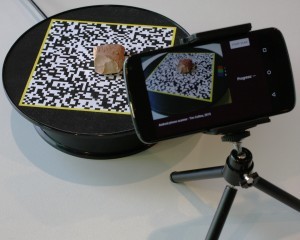3D Acquisition of Cuneiform Tablet Fragments
Virtual Representation of 3D Objects
Computers represent 3D objects with a set of points called vertices that define the shape of the object. Surfaces of the object are formed by joining vertices to form triangles. This turns what was a cloud of points into a virtual solid object with the appearance of a wireframe mesh. High resolution 3D scanners can produce virtual object models that have thousands of vertices and triangles per square cm. Different optical scanning techniques can be used to acquire 3D models. However, commercial optical scanners can be expensive, unsuited to mobile use, and require user expertise and careful calibration.


Low-cost Photogrammetric Acquisition
We have developed a low-cost, lightweight 3D acquisition system that does not require user expertise or calibration. The system is based on photogrammetry and can be realised in an ultra-low-cost form using a turntable and smartphone with a total cost of approximately $100. The photogrammetry uses sets of 2D photographs taken from different angles to construct a 3D model. This approach is called Structure from Motion (SfM). The surfaces of the generated 3D object model are rendered with the photographic detail to create a more “real” object appearance. The results of experimental testing have shown that the system can acquire models with accuracies equivalent to commercial scanners.
You can read more about the technique here:
T. Collins, S.I. Woolley, E. Gehlken and E. Ch’ng, “Automated Low-Cost Photogrammetric Acquisition of 3D Models from Small Form-Factor Artefacts”
Electronics, 8(12)-1441, 2019. (Full Text)